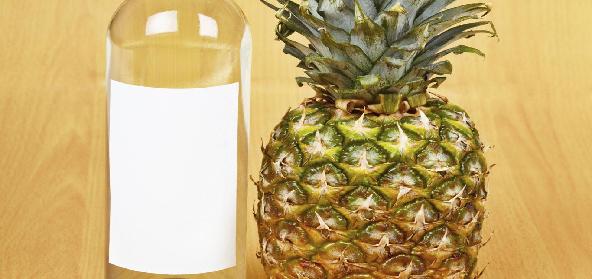Have you ever tried pineapple wine? Its is absolutely delicious.
Here is a simple and effective method to make delicious pineapple wine at home. The flesh of a fresh pineapple is unbelievably sweet and the flavor intense and you get really good pineapples in Indonesia at rock bottom prices.
Ingredients
| 10 Pineapples | |
| 1 1/2 kg white sugar | |
| 1/4 tsp sodium metabisulphite | |
| 1 1/2 tsp yeast | |
| 1 tbsp bentonite | |
| 1 tbsp sodium metabisuplhite (dissolved in 100 ml water) |
UTENSILS
Glass, ceramic, stainless steel or enamelled containers. A large acid jar is suitable for fermentation. Aluminium or cast iron containers should not be used since the acid in pineapple juice attacks these metals.
Others equipment:
-
Fermentation lock: It is a simple device used on the mouth of the fermentation vessel to prevent the entry of wild yeast spores present in the atmosphere while at the same time allowing the carbon dioxide gas formed during fermentation to escape. A plug of cotton wool can also be used for this purpose.
-
Disintegrator: A kitchen mincer, liquidiser or other suitable disintegrator is used for pulping the pieces of pineapple.
Process
-
Peeling and cutting: Pineapples are washed well and peeled. The flesh is cut into pieces leaving out the core.
-
Juice extraction: The pineapples pieces are crushed in a suitable disintegrator. The juice is extracted by manually squeezing the pulp through a clean cloth. Ten pineapples will give about seven liters of juice.
-
Fermentation: The fermentation vessels are washed thoroughly and disinfected by rinsing with a 10 per cent solution of sodium metabisulphite by dissolving 10g of sodium metabisulphite in 100ml water. The pineapple juice is then poured into the fermentation vessel and 1/4 teaspoon of sodium metabisulphite is dissolved in this juice to prevent the growth of wild years and bacteria during fermentation.
The years is made into paste with a little pineapple juice and this paste is added to the bulk of the juice in the container. The mouth is closed with a fermentation lock or a plug of cotton wool. White sugar is added 24,48 and 72 hours after the introduction of the years. Fermentation is completed in five days. The clear liquid layer which is the crude wine is poured out or siphoned off into another container. -
Clarification: Bentonite clay is made into a paste with a little of the crude wine and added to the bulk of the liquid. This is them mixed thoroughly and allowed to settle for 24 hours.
-
Bottling: The bottles are washed well with water and rinsed with a solution of sodium metabisulphite. The clarified wine is siphoned off into these bottles which are them stoppered with crown corks or cork stoppers.
-
Maturation: The bottles are stored to allow maturation of the wine and to aid removal of sediment. Rebottling should be done at three-month intervals to remove sediment. Any sediment formed should be removed by decantation of the wine which is then rebottled.
-
The final product: The wine obtained by this method is pale brown in colour and is very clear. The alcohol content is about 15 per cent and sugar content about 10 per cent.





